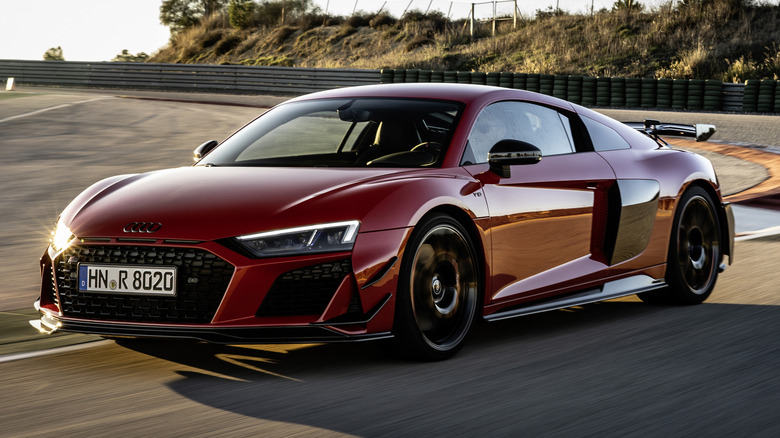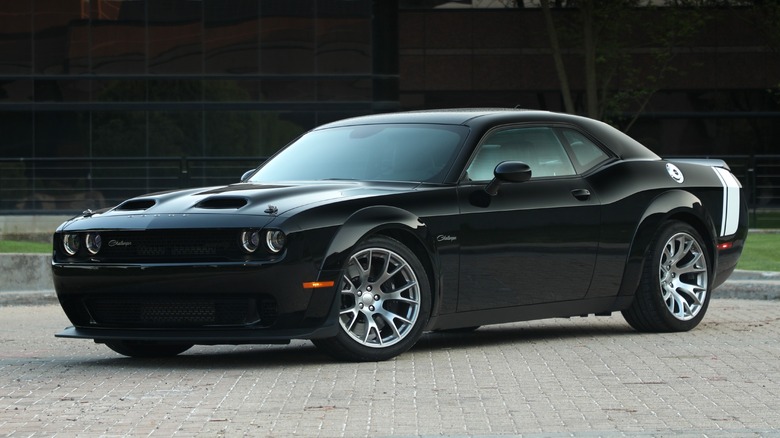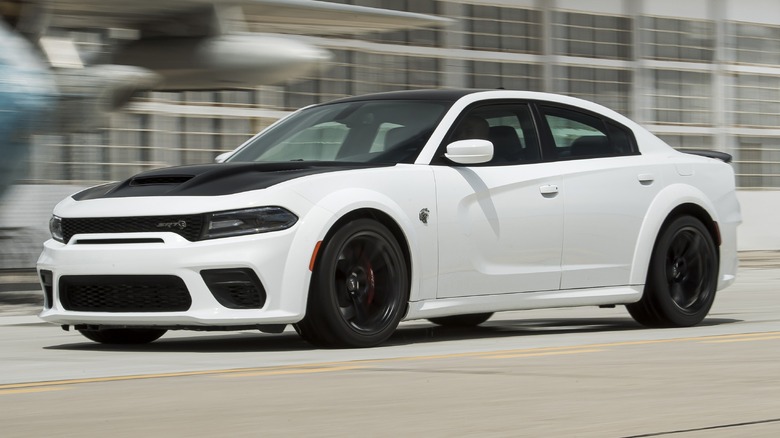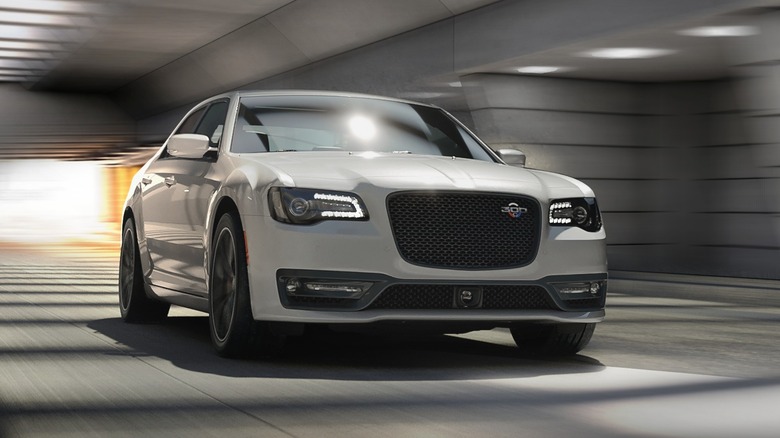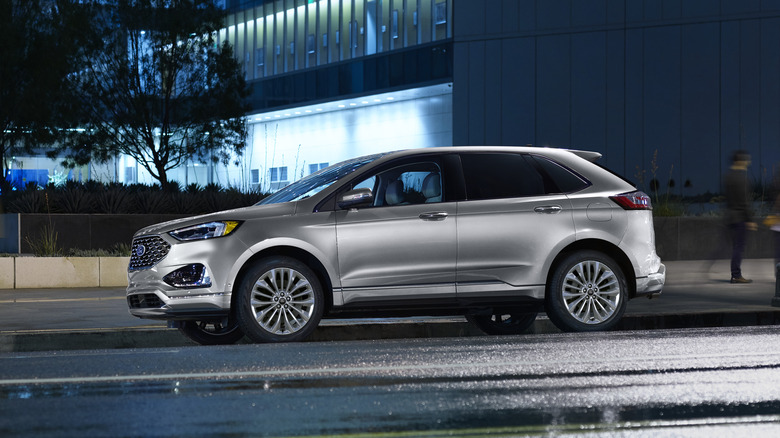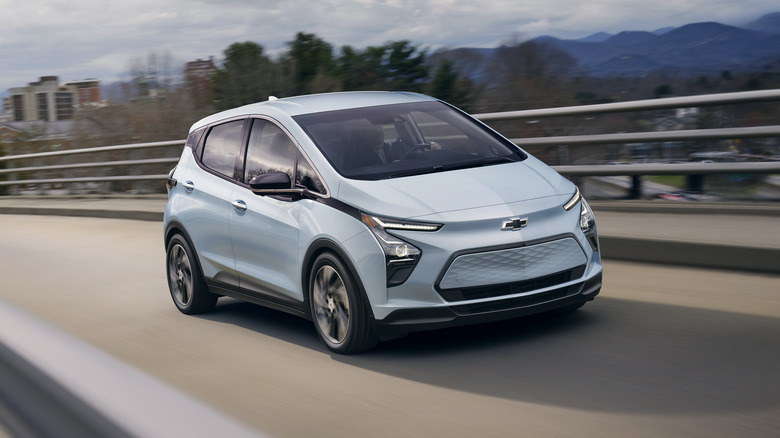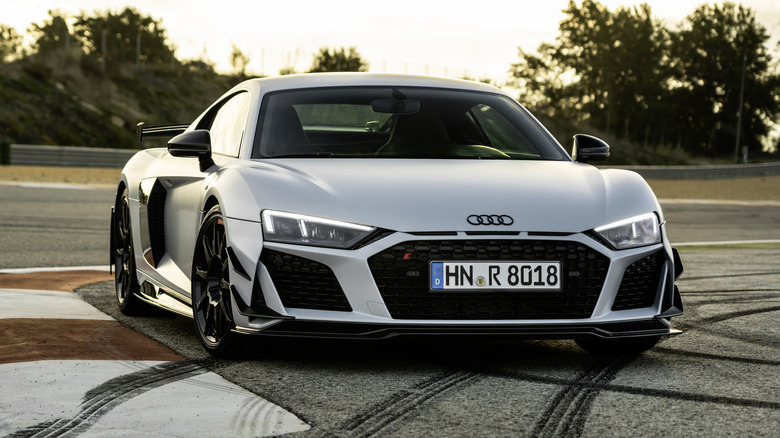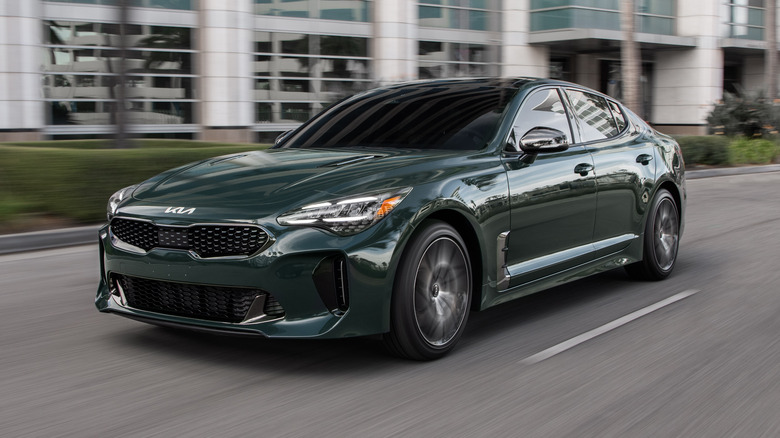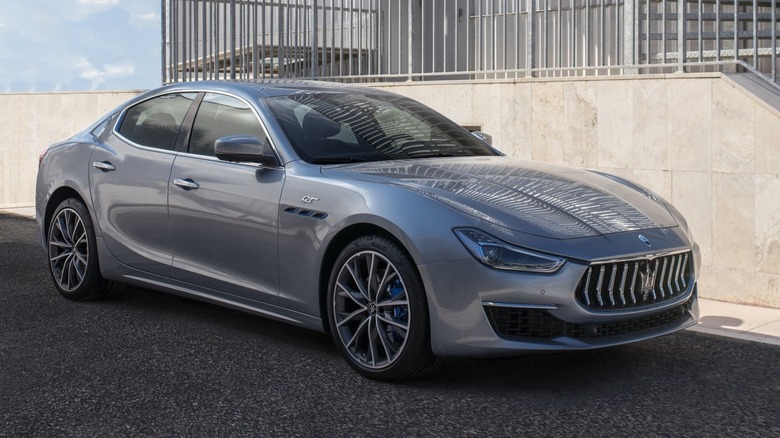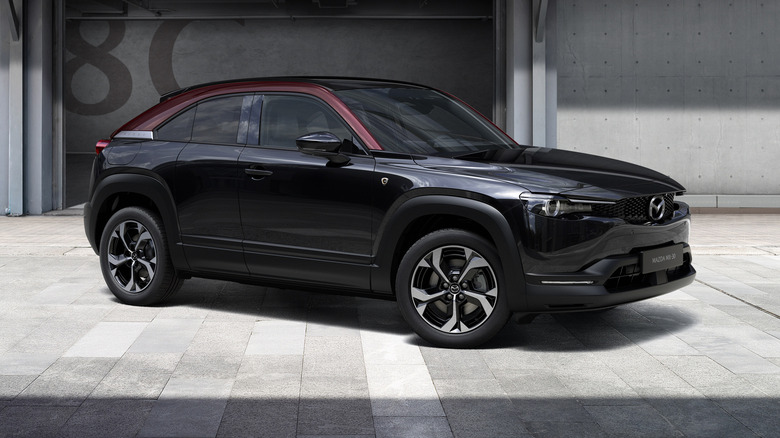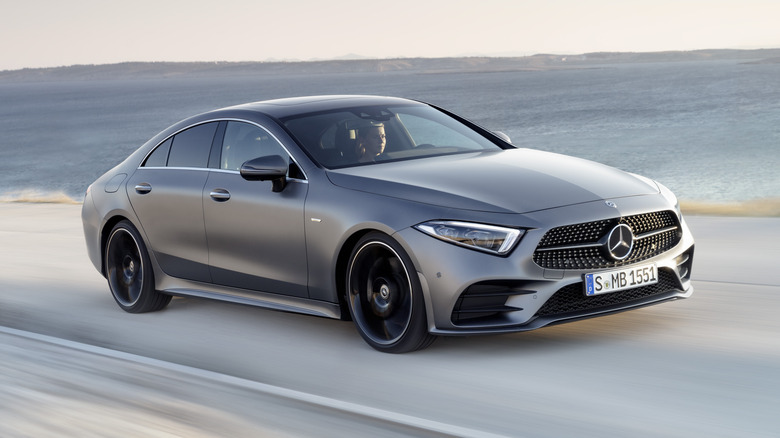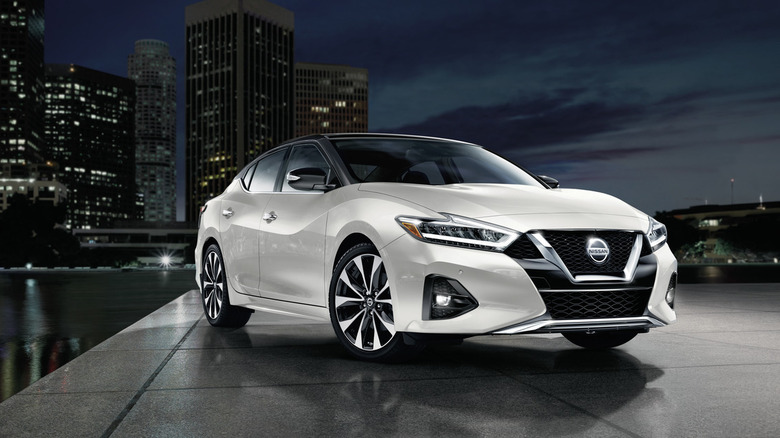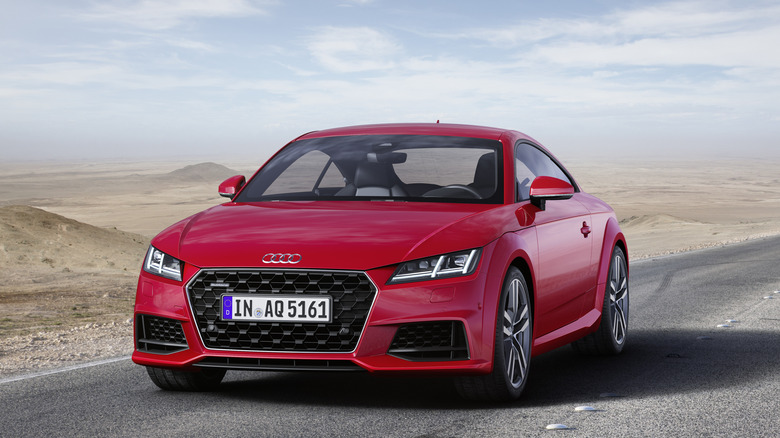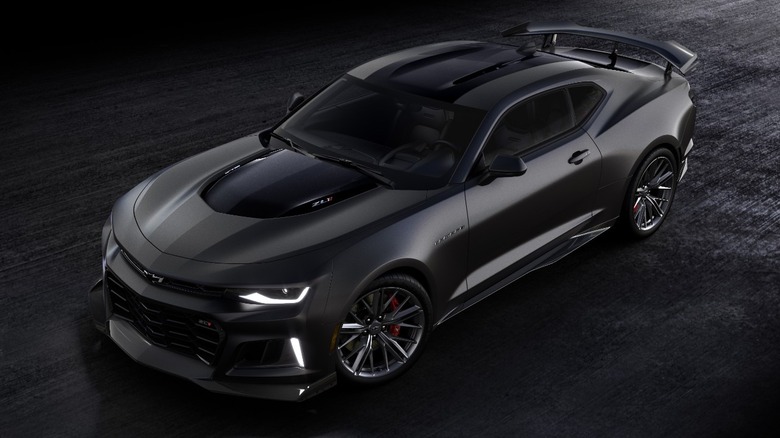Every Popular Car Being Discontinued In 2024
As consumer tastes change and manufacturers look to weed out the underperforming models in their lineups, it's natural to see car models discontinued every year and new ones emerge. However, that process has been supercharged in recent years, primarily because of the industry-wide switch to EVs. In order to free up factory facilities to make hybrid and all-electric vehicles, many brands have had to trim down their current lineups significantly. As a result, it's inevitable that some much-loved cars end up on the chopping block.
In 2022, almost every major manufacturer axed at least one underperforming model, and in 2023 the results were similarly severe. As the transition to electric vehicles continues to accelerate, the list of models set to be discontinued by 2024 sees just as many popular cars bow out. Some have been expected for a while now, but a few of the axed nameplates came as a major surprise to fans when they were announced.
Dodge Challenger
After a decade and a half of production, Dodge is discontinuing the Challenger and Charger after the 2023 model year. The last cars are set to roll off the production line in December 2023, with the final customers receiving their cars in early 2024. It won't be the end of the two nameplates – both are slated to reappear as EVs in the near future – but it marks the culmination of a long and very successful run that played an integral part in defining Dodge's current brand image and appeal.
Stellantis has its work cut out to convince the Challenger's current fanbase that an electric car is a worthy replacement, but for now, an array of special edition Last Call cars have been unveiled to commemorate the gas-powered Challenger's last model year. That includes the Dodge Challenger SRT Demon 170, which boasts a 0-60 mph time of just 1.66 seconds and a whopping 1,025 horsepower. It's the most powerful production car that Dodge has ever built and is strictly limited to a maximum of 3,300 units, with 3,000 for the U.S. and 300 for Canada.
Dodge Charger
The Challenger and Charger replacements certainly have big shoes to fill, but it seems Dodge is intent on delivering a car that, on paper at least, is capable of beating the top-spec gas-powered models. Dodge has so far confirmed that the entry-level Charger EV will make 455 horsepower, while the mid-range model will make 590 horsepower. Various upgrade packages will also be available to take these variants to 535 horsepower and 670 horsepower, respectively.
There will also be a top-spec SRT variant with significantly more power available, although for now, no numbers have been released. If the company is to prove it's serious about making electric muscle the natural successor to gas-powered engines, it'll need to top the 1,025 horsepower on offer from the 2023 Challenger SRT Demon 170.
Electric cars with four-digit horsepower figures are already available at the top end of the market, with the Tesla Model S Plaid offering 1,020 horsepower and the Lucid Air Dream Edition Performance offering 1,111 horses. It's not unreasonable to think Dodge would have to beat both of them to truly assert itself as the king of electric muscle.
Chrysler 300
Another casualty of the electric revolution is the long-running Chrysler 300, which is also being axed by parent company Stellantis alongside the Dodge muscle twins. A final commemorative edition was launched for the 2023 model year, with a 6.4L Hemi V8 making 485 horsepower. It's limited to 2,200 units, with 200 of those being designated for Canada and the rest for the U.S. market. The 300 was a veteran model by modern standards, having remained on sale largely unchanged since it was first relaunched in 2005. However, with Chrysler committing to switch to full electrification over the coming years, its days were always going to be numbered.
It leaves the brand in a very strange place for the 2024 model year. With the 300 dead and its first EV not expected to hit the road until 2025 at the earliest, only one model remains in its lineup, the Pacifica minivan. The upcoming Chrysler EV is billed as the replacement to the 300 and reportedly will be a fresh design after the previous Airflow concept was binned in a shakeup earlier this year. An aging minivan and an unproven EV design are hardly a solid foundation for a revival of the once-great American marque, and it remains to be seen what Stellantis' future plans for the brand are over the long run.
Ford Edge
It's not just V8 performance cars that are falling victim to the race to get EVs into dealerships. The Ford Edge crossover is also set to be discontinued after the 2023 model year, as the brand's Oakville plant that currently produces the car is set to be retooled to be ready for EV production to begin in 2025. U.S. sales of the Edge have been falling for the past few years, with over 138,000 examples sold in 2019 but only around 85,000 sold in 2022.
This is likely in part due to the global chip shortage, but it's telling that Ford has decided to axe the Edge even in a market where crossover SUVs in general continue to be very popular. Another factor in the Edge's demise was reportedly labor disputes at the Oakville plant, with the commitment to EVs being part of a package to settle disagreements with the workers' union. After the deal, the Edge was left without a production plant, and it seems Ford made the decision to simply discontinue it rather than move production elsewhere.
Chevrolet Bolt EV
One of the most common complaints about EVs is their higher price and lower range compared to affordable gas-powered cars. The Chevrolet Bolt EV offers a solution: it starts at around $26,000 and sports over 250 miles of range. It's one of very few properly affordable EVs on the market, but alongside the larger Bolt EUV, it's being discontinued after the 2023 model year. GM has said the main reason for this is that it uses old EV architecture, which makes it unable to support the latest features, including Super Cruise.
It's being replaced by the Equinox, a small crossover EV based on GM's Ultium platform that will debut for the 2024 model year. The exact pricing hasn't been announced yet, but it likely won't be as cheap as the Bolt. However, it should offer faster charging, more room, and a range around the same as its predecessor. Expect to see more details over the coming months and for orders to open in late 2023.
Audi R8
Audi's flagship supercar is nearing the end of its life after being first introduced for the 2008 model year, with a second generation arriving in 2017. The news was first confirmed by Car and Driver during a test drive of the new R8 GT, which will serve as a swansong for the long-running supercar. Unlike many discontinued models, the R8 isn't set to get an electric successor, at least not anytime soon. Rumors have been circulating that Audi had an EV replacement in the works, but Audi has so far claimed there is no replacement for now.
If there is in fact one on the way, it's likely to be early in development and therefore years away from production. Car and Driver reported that a 2029 launch would be the earliest possible release date, although that's barring any delays in development and assuming the fact that Audi is indeed planning to directly replace the flagship supercar. For now, it appears that the R8 GT will mark the end of an era for the German manufacturer.
Kia Stinger
Sport sedans aren't as popular as they once were, with even the best performers in the segment struggling to attract enough sales to remain financially viable. The Kia Stinger couldn't quite make the grade and is being discontinued after the 2023 model year, with a limited-run Tribute Edition to commemorate its run. It's easy to forget how rapidly the brand perception of Kia has changed –- just a decade or two ago, the idea of Kia making a sports sedan with over 350 horsepower would have been laughable.
However, the Stinger proved that not only could it make cars with BMW-baiting performance, but it could make them look the part too. Sadly, that never translated into sales success for the Stinger, and rumors had been circulating that it was due for the chopping block long before its demise was officially announced. However, there's still just about time to buy one before they're gone, with starting prices remaining just under $40,000.
Maserati Ghibli
Another performance sedan that's on its way out in 2024 is the Maserati Ghibli, which is being axed in preparation for an EV replacement to debut by 2025. This was perhaps inevitable given that Maserati is planning to electrify its whole lineup from the middle of the decade, and the Ghibli was never a bestseller to begin with. Its replacement is reportedly set to split the difference between the Ghibli and the Quattroporte, measuring in somewhere between the two current models to serve as the brand's only electric sedan.
Unfortunately for the Ghibli, it will probably be best remembered as the BMW rival that couldn't quite stack up to the best of what the Germans could offer. That reputation, alongside its patchy record on reliability, saw prices tumble. The cheapest examples of the car now sell for less than $20,000, even though the base-spec 2023 model costs $85,300. For that, buyers get a V6 under the hood making 345 horsepower -– for context, a well-specced Kia Stinger offers more power, faster acceleration, and a faster top speed. Not to mention, it costs tens of thousands of dollars less.
Not every 2024 discontinuation is deserved, but it's hard to find a compelling reason why Maserati should keep the Ghibli around for another year.
Mazda MX-30
Combining the green credentials of an EV with the sprightly driving dynamics of Mazda's best crossovers should have been a recipe for a very popular car indeed. However, the MX-30 was a swing and a miss from the Japanese automaker, and now it's being discontinued after the 2023 model year. The biggest issue, notwithstanding the fact that it was only sold in California and therefore inaccessible to the majority of the population, was its paltry range.
Most EVs now offer ranges somewhere north of 200 miles, with the best of them offering double that figure. However, the MX-30 could only manage 100 miles between charges. That might have been acceptable to buyers if the car was exceptionally cheap, but at a starting MSRP of $34,110, it was more expensive than the likes of the Nissan Leaf and Chevy Bolt. It's almost a surprise that Mazda even bothered launching it at all, but sales will end later this year, a mere two years after order books initially opened.
Mercedes-Benz CLS
The first generation of the Mercedes-Benz CLS was instrumental in helping kickstart the four-door coupe trend that every major German manufacturer has now adopted, but production is set to end after the 2023 model year. It comes as part of a shakeup aimed at reducing the number of niche models the brand offers, with the goal being to direct buyers to the new E-Class instead. Both cars share the same underpinnings for 2023, but a new generation of the E-Class is set to debut for the 2024 model year, while the CLS is consigned to the archives.
The manufacturer's push into the EV world has meant its already wide-ranging lineup has expanded even further in recent years, and with more electric vehicles on the way, some of the gas-powered cars had to go. A number of C-Class and E-Class variants are also being killed off at the same time, with convertibles, coupes, and wagons all set to disappear from the lineup. If that wasn't enough, Mercedes also plans on weeding out the rest of its underperforming models over the coming years, although the full list of axed cars hasn't been confirmed so far.
Nissan Maxima
It's been a tough year for sports sedans. The Nissan Maxima is also ceasing production after the 2023 model year as the brand pivots to more eco-friendly powertrains and the sedan market continues to shrink. It has been widely reported that an EV successor is on the way, and Nissan has hinted as much, but so far, details are few and far between. The final Maxima is set to roll off the production line in mid-2023, bringing an end to the current generation, which failed to excite enthusiasts in the way previous generations did.
Nissan is in the midst of making the switch to electrification, with over a dozen EV models planned to launch before the end of the decade. Whether one of those becomes a direct successor to the Maxima or whether a performance-oriented crossover debuts in its place remains to be seen. Either way, at least it seems like Nissan isn't planning to kill the nameplate off entirely.
Audi TT
Alongside the R8 supercar, the smaller Audi TT is also set to be discontinued after 2023. A commemorative Final Edition was launched earlier in 2023 for certain markets, but the U.S. missed out on the limited run. The regular TT remains on sale for as long as inventory allows, with the TT Coupe, TTS Coupe, and TT Roadster all available for the 2023 model year. The range-topping TT RS, however, already bowed out after 2022.
The market for small sports cars is not as lucrative as it once was, and many brands have shrunk their lineups or killed them off entirely in recent years. Some are slated to return as EVs, and the TT is no different -– although it's not going to be a direct replacement. An executive told Auto Express that Audi couldn't "just say we'll do the TT in an electric way" and that in building a successor, the brand aims "to surprise our customers."
Exactly what that means remains a mystery for now, but the outlet speculates that an electric sports car with crossover influences remains the most likely candidate.
Bonus: Chevrolet Camaro
Although it will technically survive into the first few weeks of 2024, it would be remiss not to mention the impending retirement of the current-generation Chevy Camaro. Orders are now being taken for the 2024 model year car, with the final example set to be produced in January 2024. GM has hinted that the Camaro will likely have an electric successor but so far has stopped short of confirming exactly what it might look like or when it might launch.
This came as somewhat of a surprise when it was announced given that Ford has just unveiled the seventh-generation Mustang, which is set to go on sale for the 2024 model year and does not feature any kind of electrification. Clearly, GM chose not to make a direct rival to the new pony car, but the big question is what it chose to develop instead. With Dodge taking the electric muscle route, there's a possibility that a new EV Camaro could be just around the corner. For now, though, it's au revoir but not goodbye to Chevy's iconic performance car.
